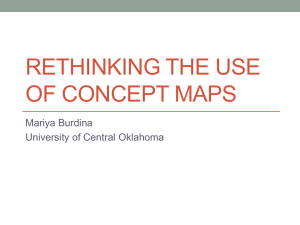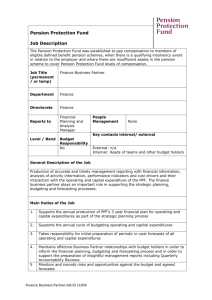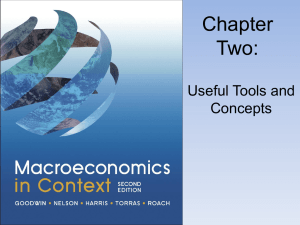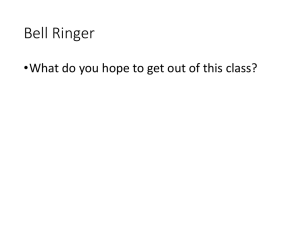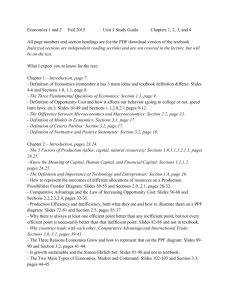DOCX, 290.7 KB, 13 pp. - Department of Transport, Planning and
advertisement
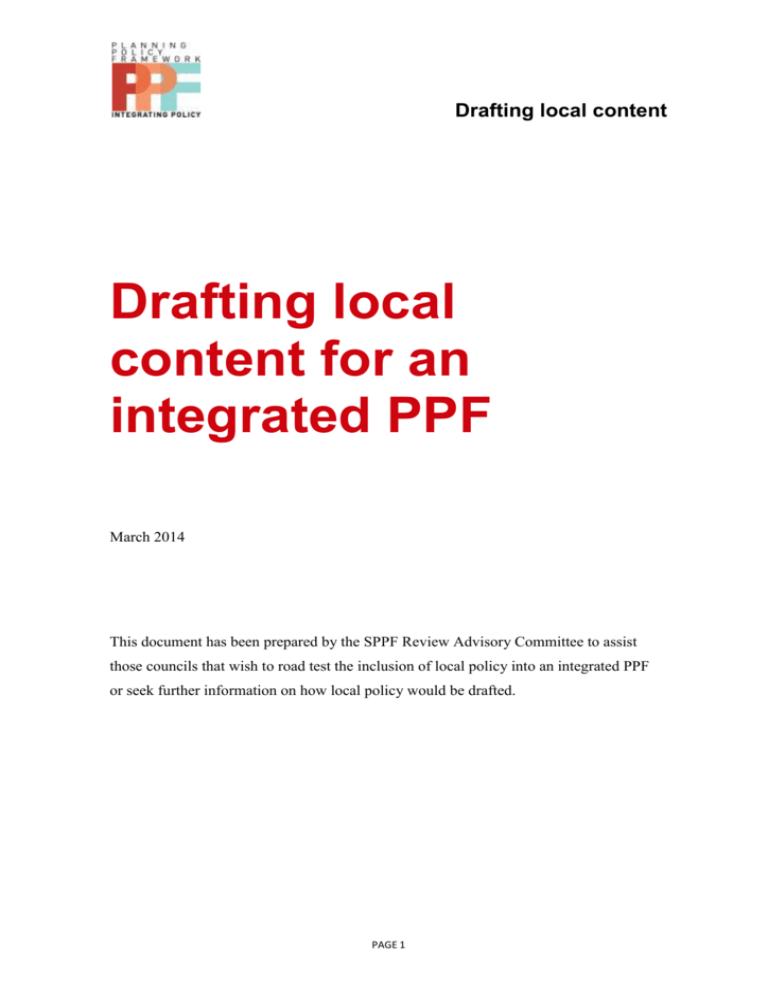
Drafting local content Drafting local content for an integrated PPF March 2014 This document has been prepared by the SPPF Review Advisory Committee to assist those councils that wish to road test the inclusion of local policy into an integrated PPF or seek further information on how local policy would be drafted. PAGE 1 Drafting local content 1. What policy can be included? Existing policy should be reviewed before it is included in the PPF. New policy must meet each of the following rules of entry to be considered for inclusion in the PPF. 1.1 Status of policy Rule 1 At the local policy level, the policy must be formally adopted policy of the relevant planning authority, or the State Government. Interim policy, ideas intended to be policy one day or matters being thought about as proposed policy should not be included. 1.2 Relevance Policy needs to be relevant. Rule 2 The policy must achieve at least one of the following four objectives: a) facilitate sound, strategic planning and co-ordinated action at State, regional or municipal levels b) facilitate the integration of land use and development planning and policy with environmental, social, economic, conservation and resource management policies at State, regional or municipal levels c) facilitate development d) facilitate positive actions by responsible authorities and planning authorities to meet the planning objectives of Victoria. Rule 3 The policy is best applied through the land use planning and development system. PAGE 2 Drafting local content 2. Drafting This section provides advice on how local content can be drafted for the PPF. 2.1 Name of policy The name can repeat the state or regional level name if it covers the same topic. 2.2 Explanatory paragraph and application If needed, a short context paragraph can be included; this should focus on material needed to understand the policy. It should be brief. More extensive context material and background statistics, where required, can be accommodated in the context clause. This section can also specify where the policy applies, or does not apply. 2.3 Objectives Objectives are the planning scheme’s aims for development and flow from an overall vision for a municipality. Objectives begin with the infinitive form of the verb and should follow from the statement: Council aims … To retain and protect productive farming land for agriculture Objectives should not be grouped together followed by a list of grouped strategies. Instead, one objective should be supported by a strategy or a number of strategies. The reader should be able to clearly identify what strategy supports the objective. There can be more than one objective for each clause. It is acceptable to base a local objective on a state level strategy if local strategies are clearly related to a particular state or regional strategy. An example might be: To implement the state strategy: recognise and maintain cultural identity, neighbourhood character and sense of place. PAGE 3 Drafting local content Objectives, and their related strategies, should appear where they are mostly likely to be found by a person assessing an application. For example the objective: To keep houses away from factories should appear under a residential heading because it applies when considering residential development – not within an Industrial heading. 2.4 Strategies Strategies are ways of achieving the objectives. Strategies should be able to follow from the statement: The responsible authority will … Facilitate the use of alternative transport modes, at both the local and metropolitan levels. It is typical in planning schemes for strategies to ‘compete’ and require a balancing from decision makers on a case-by-case basis. However ‘conflicting’ strategies that are aimed at an irreconcilable end are not helpful. The following matrix of strategy verbs presents the Committee’s approach to the use of verbs in strategies based on the policy approach to be taken and the type of action to which the policy is directed. The matrix identifies whether the strategy has a focus of facilitation, regulation, further planning work or identifying matters for consideration. PAGE 4 Drafting local content Matrix of strategy verbs Make it happen (facilitate support) (should Support Create Improve Repair Facilitate Provide Upgrade Reinforce Maintain Preserve Reduce (the adverse impact) Build new ACTION THEMES APPROACH TO BE TAKEN Support it happening Control what happens Decide Plan Conserve must) Require Restore Protect Reinforce Avoid (the adverse impact) Minimise (the adverse impact) Recognise Balance Prepare (a specific type of plan) Plan/design Use (a specific technique or approach) Drafting a strategy that takes a decision maker to an external document is poor practice. Avoid strategies such us: Manage the retail hierarchy in accordance with the Gumnut Retail Strategy. The relevant parts of the external document need to be part of the scheme. For example, the relevant classification of centres from the Gumnut Retail Strategy should be included in a table in the PPF. 2.5 Guidelines for decision makers Guidelines for Decision makers might contain three types ‘policy guidance’: 1. Application requirements 2. Criteria for the exercise of discretion 3. Issues to be considered when making a decision (called somewhat confusingly ‘Decision Guidelines’ in the VPP). Not all themes would need to provide all these types of guidance. PAGE 5 Drafting local content 2.5.1 Application requirements All schemes list information that must be presented as part of certain applications. The details of this information are contained in some of the clauses setting out specific requirements, in some zones and overlays and in schedules. They are also typically set out in some policies. An appropriate form of words for application requirements would be: Application information: 1 Request [specify proposals] provide the following information as appropriate: (a) [List of specific information to be supplied]. 2.5.2 Criteria for the exercise of discretion The second possible role for policy guidance is setting out standards against which to assess applications. This is one role that Local Planning Policies currently fulfill. This sort of ‘policy guidance’ is best expressed as standard using the verb ‘should’ (or ‘may’ where it indicates a possible approach). Examples of this form of guidance are: 1. Development should not exceed 8 metres. 2. Building site coverage should not exceed 50 per cent. 3. Plant and equipment on roofs should generally not be visible. 4. Development should be stepped with slope so that changes in natural ground level do not result in built form with a visual bulk that undermines the low-rise and fine-grained character of the centre. 5. Remnant vegetation within wetland areas or adjoining any watercourse should not be removed, unless offsets are provided to achieve a net ecological gain. 6. Each dwelling should have convenient access to at least 6 cubic metres of externally accessible, secure storage space. 7. Car spaces may include trees planted with flush grills 2 metres by 2 metres set at 45 degrees to the car space at the rear corners. PAGE 6 Drafting local content An appropriate form of words for application criteria would be: Guidelines: 1. [Guideline text here using ‘should’ (or may if appropriate)]. If the guidelines relate to different types of a proposal this can be identified after the introductory ‘Guidelines’, for example Guidelines for subdivisions: 1. [Guideline text here using ‘should’ (or may if appropriate)]. Guidelines for outbuildings: 1. 2.5.3 [Guideline text here using ‘should’ (or may if appropriate)]. Issues to be considered when making a decision The final type of guidance that we can identify is additional ‘decision guidelines’. An appropriate form of words for additional decision guidelines, if ever needed, would be: Consider as relevant: 1. [This list should comprise a list of policy neutral issues]. 2. [Only reference to incorporated documents in this list]. It is not appropriate to make general reference to external strategy documents or reports in this section. Any reference needs to be to an incorporated document that has been specifically drafted to be legally part of the planning scheme. In some cases councils may wish to provide more extensive guidelines to applicants than is appropriate to include in a policy or control. In this case, the policy can contain the key objectives or guidelines and an external document can provide general advice on how those guidelines can be met, including illustrative material if need be. In this way the actual guidelines are in the scheme, and informal advice on how to meets those requirements are in the external document PAGE 7 Drafting local content 2.6 Strategic planning guidelines It can be useful to provide guidance on the future application of zones, or strategic work that will affect the way an area is managed. An appropriate form of words for strategic planning guidelines is: Strategic planning should: 1 [List of guidelines beginning with a verb from the ‘List of strategic planning guideline verbs’] 2 Consider proposals for application of the Rural Activity Zone in the Gumnut Downs to provide for tourism facilities on a case-by-case basis. List of strategic planning guideline verbs a) b) c) d) Monitor, consider Review Plan, Prepare (a specific type of plan), Identify Use Some schemes provide guidance on the use of particular zones, for example the Rural Activity Zone. This can be expressed as follows: Strategic planning should: 1. 2.7 Use the Rural Activity Zone to facilitate tourism facilities in Gumnut Downs on a case-by-case basis. Application of zones and overlays Section 12A(3) of the Planning and Environment Act 1987 states: (3) A municipal strategic statement must contain— (c) a general explanation of the relationship between those objectives and strategies and the controls on the use and development of land in the planning scheme; and As local policy has been developed there has been some questioning of the usefulness of some types of implementation statements. For example, it is not uncommon to find implementation statements along the lines of: Applying the Residential 1 Zone to established residential areas. PAGE 8 Drafting local content If implementation statements about ‘using zones’ etc are to have any use, they must be a general statement that reflects the scheme as it currently stands; not a statement about the changes that were made in the last major amendment. Apply: 1 2.8 [Try to make this useful]. Background documents Background documents are reference documents that provide background information to assist in understanding the context within which objectives, strategies and guidelines have been framed. The Practice Note Incorporated and Reference Documents (August 2000) includes the following commentary in relation to reference documents. Reference documents provide background information to assist in understanding the context within which a particular policy or provision has been framed. A variety of different types of document may perform this role. They may be wide ranging in their content and contain information not directly relevant to specific decisions under the planning scheme. … Reference documents can be used in a number of ways. They can be used as a basis for preparing the Municipal Strategic Statement (MSS), local planning policies or requirements in the planning scheme, or can be mentioned in the planning scheme as a source of useful background information. Some councils have an unwarranted expectation about the statutory role of reference documents. Reference documents have only a limited role in decision-making as they are not part of the planning scheme. They do not have the status of incorporated documents or carry the same weight. The move towards the use of the term background documents instead of refrence documents is to make it clearer that the documents in question form background to policy, rather than a reference point for decision making. PAGE 9 Drafting local content 3. Styles and numbering 3.1 Styles A style is a tool used by Microsoft Word to control the appearance and layout of a document. The template provides a list of styles that have been specially designed and developed for use in the PPF. People drafting local content should know how to use and apply styles in Word. When done manually, formatting is laborious. It produces results that do not present a consistent structure and appearance. Manually formatted policy can change in appearance when transferred from one computer to another, sometimes damaging presentation and readability. The styles provided in the template: 1. establish the framework for a consistent structure and appearance for all policy 2. provide the basis for automated and time saving features such as tables of contents, and automatic numbering 3. significantly reduce the amount of format editing time. PAGE 10 Drafting local content STYLE NAME USE PPV_Head C Local This style is for the main numbered heading for local policy. Create another heading at this level for additional policy on a different topic. PPF_Head C Tagline This immediately follows head C and gives information on the application of the policy and the amendment and approval date that introduced the policy PPF_Body text This style is for un-numbered text. PPF_Head E This style is for the defined headings within a policy: 3.2 Objectives and strategies. Guidelines for decisions makers Strategic planning guidelines Application of zones and overlays Background documents PPF_Objective This style is for objectives. It will automatically renumber. PPF_Objective Bullet This is for the rare occasion that bullet points are needed in an objective. PPF_Strategy Use this style for strategies. PPF_Strategy List Use this style ‘bullet point’ sub- strategies. Avoid sub-strategies if possible. PPF_Body text List For all numbered lists PPF_Body text List (2) For second level numbering Numbering clauses Policies in the PPF appear under a third level heading. Each clause number is made up of defined parts. All single digit numbers are expressed with a leading ‘0’ to assist in automatic sorting of clauses. For local policy each Council is identified with a four letter abbreviation. Clause Sub clause Areas where policy applies Clause number 03 . 05 - gnut - 01 3.3 Numbering text within clauses The template provides for automatic numbering of strategies and listed items. Use the defined styles, do not use un-numbered bullets. Numbering has been used instead of bullet points to assist with navigation through the scheme by all users of the system. . PAGE 11 Gumnut Planning Scheme Example for illustrative purposes and template 4. Example 09.09-gnut-01 Ferret-based tourism Local Policy: Gumnut C88 1/04/2014 Ferret is the common name given to Mustela putorius furo, and is the domesticated form of the European Polecat. It is the domestic fauna emblem of Gumnut. This policy does not apply to neutered ferrets. Objectives and strategies Objective 1 To manage the adverse impacts of ferrets. Strategy 1.1 Minimise adverse impacts from the intensification of ferret-based tourism on quarries. Strategy 1.2 Use a risk-based approach to managing the impacts of ferrets, as follows: a) Avoid disturbing quarry. b) Minimise the cumulative effect of ferret-based tourism c) Remediate detrimental effects arising from past and current ferret outbreaks. Objective 2 To implement the state strategy: facilitate the development of a range of well designed and sited tourist facilities and accommodation. Strategy 2.1 Facilitate ferret-based tourism. Guidelines for decisions makers Application information: 1. Request applications for ferret-based tourism provide the following information as appropriate: (a) Location of quarry that may be impacted by ferrets. Guidelines for ferret accommodation: 1. Ferret accommodation should be located in activity centres and strategic redevelopment areas, but not near quarry. 2. Ferret accommodation established early in the life of a growth area should be located where there is access to services and public transport. Guidelines for ferret-based tourism: 1. Ferret-based tourism development may exceed preferred building heights to provide roof top ferret exercise space. Consider as relevant: 1. The impact of noise from the Paradise Gardens waste recycling depot on ferret-based tourism proposals. Strategic planning guidelines Strategic planning should: 1. Identify in the planning scheme areas suitable for ferret-based tourism. Application of zones and overlays Apply: 1. The Comprehensive Development Zone to facilitate integrated ferret-based tourism and royal tennis complexes. Background document The Gumnut Ferret Strategy (Shire of Gumnut, 2009). PAGE 12 Gumnut Planning Scheme Example for illustrative purposes and template 5. Template 01.01-gnut-01 Name of policy [Style: PPF_Head C Local] Local Policy: Gumnut [Style: PPF_ Head C Tagline] C### dd/mm/yyyy [Context material if needed. Keep this very brief. Put longer background material in context section of Clause 02 of the PPF. Include area of policy application or exclusion if appropriate]. Objectives and strategies [Style: PPF_Head E] Objective 1 To [objective text here]. [Style: PPF_Objective] Strategy 1.1 [Strategy text here. Use verbs from the ‘Matrix of strategy verbs’]. [Style: PPF_Strategy] a) [Strategy ‘dot points’]. [Style: PPF_Strategy List] Guidelines for decision makers Application information: 1. Request [specify proposals] provide the following information as appropriate: [Style: PPF_Body text List] (a) List of specific information to be supplied. [Style: PPF_Body text List (2)] Guidelines: 1. [Guideline text here using ‘should’ (or may if appropriate)]. Consider as relevant: 1. [This list should comprise a list of policy neutral issues]. 2. [Only reference incorporated documents in this list]. Strategic planning guidelines Strategic planning should: 1. [Use verbs from the ‘List of strategic planning guideline verbs’]. Application of zones and overlays Apply: 1. [Description of how controls are applied]. Background documents [Title of Document (Publishing organisation, Year)]. Table 1: [Example table] [Caption] HEADING [PPF_TABLE HEAD] HEADING [TABLE HEAD] Row 1 [PPF_Table text bold] Information [PPF_Table text] Dotpoint [PPF_Table text Bullet] Row 2 Table text bold] PAGE 13


